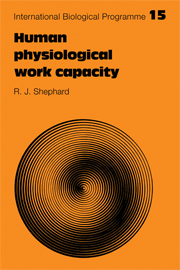Book contents
- Frontmatter
- Contents
- Foreword
- Preface
- 1 Introduction
- 2 Sampling and population studies
- 3 Methods for the measurement of physical fitness, working capacity and activity patterns
- 4 Climate, season and local geography
- 5 Socio-economic status and working capacity
- 6 Working capacity and constitution
- 7 The physical working capacity of the athlete
- 8 The growth of working capacity
- 9 Age and working capacity
- 10 Epilogue
- IBP Human Adaptability section publications
- References
- Index
8 - The growth of working capacity
Published online by Cambridge University Press: 20 May 2010
- Frontmatter
- Contents
- Foreword
- Preface
- 1 Introduction
- 2 Sampling and population studies
- 3 Methods for the measurement of physical fitness, working capacity and activity patterns
- 4 Climate, season and local geography
- 5 Socio-economic status and working capacity
- 6 Working capacity and constitution
- 7 The physical working capacity of the athlete
- 8 The growth of working capacity
- 9 Age and working capacity
- 10 Epilogue
- IBP Human Adaptability section publications
- References
- Index
Summary
In this chapter, we shall examine the influences of environment and heredity upon the growth and development of working capacity, considering also problems of methodology, activity patterns and facets of athletic performance peculiar to the child.
Considerations of methodology
Types of survey
There are three potential approaches to the study of growth and development (Shephard & Rode, 1975). The traditional method is well exemplified by the IBP study in Saskatoon (Bailey et al., 1914b) and an analogous study of French Canadian schoolchildren (Shephard et al., 1974b). Cohorts of children are followed in a longitudinal fashion, with observations being repeated at intervals of six to twelve months, for a total period of ten to fifteen years. This technique allows a rather precise definition of growth spurts, but it is expensive and time-consuming, particularly if the tests to be used are more than simple measurements of body dimensions. Further, in primitive societies affected by rapid acculturation, there is a danger that normal processes of growth will be confounded with changes brought about by alterations in habitual physical activity, diet and other environmental variables.
The cross-sectional survey is a much cheaper alternative, used for example in many of the Czechoslovakian and Japanese contributions to the IBP (Seliger, 1970; Hasegawa et al., 1966; Ikai, Shindo & Miyamura, 1970; Matsui et al., 1971). In a relatively stable industrialized society, a useful overall picture of development is obtained.
- Type
- Chapter
- Information
- Human Physiological Work Capacity , pp. 179 - 232Publisher: Cambridge University PressPrint publication year: 1978
- 1
- Cited by



